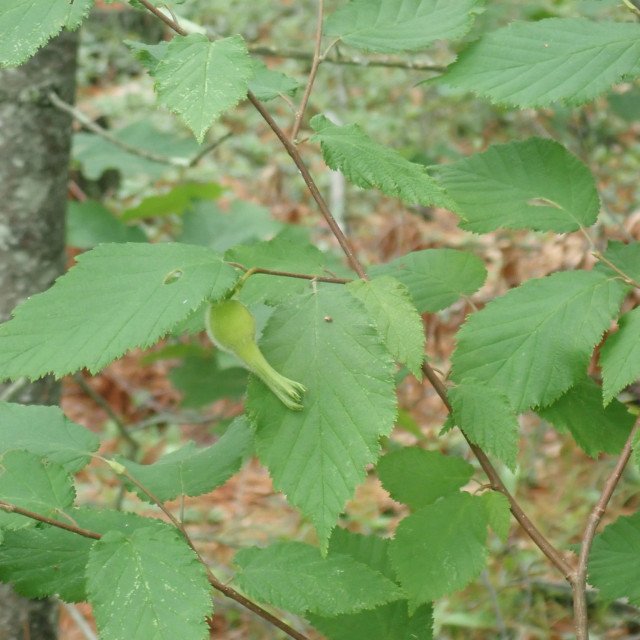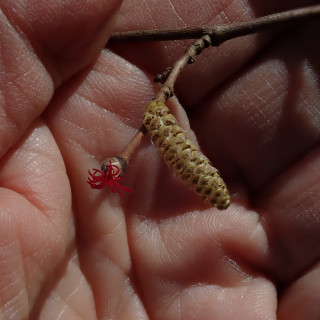COMMON NAME
Beaked hazelnut
SCIENTIFIC NAME
Corylus cornuta
ALSO KNOWN AS
beaked filbert
Plant family
Birch (Betulaceae)
Plant group
Deciduous Trees and Shrubs
Beaked hazelnut is a perennial, deciduous, thicket-forming shrub native to North America.
173 reports
48+
OBSERVERS
173+
OBSERVATIONS
Identification hints
The beaked hazelnut is a deciduous, multi-stemmed thicket-forming shrub. It's namesake is the fruit, which has a husk that surrounds the nut by at least an inch, forming the "beak". There are two recognized varieties of this species, the eastern (Corylus cornuta var. cornuta) and western (Corylus cornuta var. californica) varieties. The western variety has husks shorter than 3cm and the eastern variety has husks longer than 3cm. Another similar-looking species, American hazelnut (Corylus americana), can be found in some of the same locations as beaked hazelnut. In contrast to beaked hazelnut, American hazelnut has has glandular hairs on twigs, leaf stalks and husks, and the husks lack the long distinctive beak. In addition, beaked hazelnut prefers moister sites, whereas American hazelnut prefers drier sites.
Did you know?
Most commercially-available hazelnuts come from a different European hazelnut species, although many cultivated hazelnuts have been hybridized with this species to improve disease-resistance. Many animal species rely on the beaked hazelnut as a food source, from birds and squirrels to beavers and deer. Animals generally eat the catkins and nuts of the plant. Humans also have used the nuts of this plant as a food source for centuries.
DISTRIBUTION IN TH U.S.
Alabama
,
California
,
Colorado
,
Connecticut
,
Delaware
,
Georgia
,
Iowa
,
Idaho
,
Illinois
,
Massachusetts
,
Maryland
,
Maine
,
Michigan
,
Minnesota
,
Montana
,
North Carolina
,
North Dakota
,
New Hampshire
,
New Jersey
,
New York
,
Ohio
,
Oregon
,
Pennsylvania
,
Rhode Island
,
South Carolina
,
South Dakota
,
Tennessee
,
Virginia
,
Vermont
,
Washington
,
Wisconsin
,
West Virginia
,
Wyoming
HABITAT
Beaked hazelnut tolerates a range of lighting and soil conditions but prefers open canopy forests and does not tolerate dry, hot, constantly sun-exposed areas. The eastern variety (Corylus cornuta var. cornuta) is found throughout most of the species range except California and Oregon, whereas the western variety (Corylus cornuta var. californica) is found along the Pacific coast including in Canada, but at the northern part of the range is found only at lower elevations (below 2,600 feet above sea level).
ATTRIBUTES
Leaves
Beaked hazelnut leaves are arranged alternately along stems. Leaves are typically 2½ to 4½ inches long and 1¼ to 3 inches wide making them generally oval with pointed tip and a rounded to somewhat heart-shaped base. Edges are doubly toothed somewhat jagged looking. The leaf surface is dark green above and paler below with more hairs on the underside along the veins.
Flowers
The flowers of beaked hazelnut are either male or female but both flower types are found on the same shrub. Male flowers are arranged in catkins that look like narrow hanging clusters up to 3 inches long. In contrast, female flowers are much less conspicuous and look like tiny buds with a frill of dark red styles coming out of the tip.
Fruits
The nuts are similar to hazelnuts you find in the market, although those typically come from a different European species or cultivated hybrid. The beaked hazelnut ranges up to half an inch in diameter and is covered in a green husk with a long tubular "beak", hence the common name, Up to six nuts are found in a cluster.
Bark
The older bark of beaked hazelnut is smooth or scaly and dark brown. The twigs are yellowish green to light tan and can be hairless or have a few hairs. The hairs are sometimes glandular (sticky), so if you look at them with a magnifying glass they might have little blobs (glands) at the tips.
Bloom Time
Beaked hazelnut blooms between March and June depending on location.
See Menu
- 2021 Chicago Botanic Garden. All Rights Reserved.
-
Creative Commons
BY-NC-SA 4.0 - Terms of Use
- Privacy Policy
- Data Sharing and Citation Policies
- 2021 Chicago Botanic Garden. All Rights Reserved.




